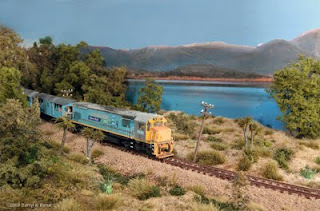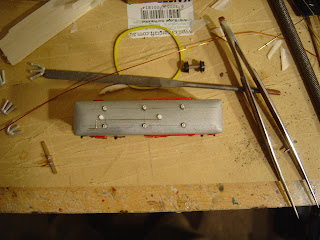DB says: Every once and a while someone wanders into the hobby's consciousness and in their own quiet way, shake things up a bit for the better - the late Brian Cross and his RTV molding, John Agnew and his Railmaster kits, Lawrence Boul's meticulously detailed styrene models, Peter Ross' search for the perfect long grass and in our humble scale: the late, great John Rappard, who took NZ120 out of crazy-impossible-dreamland to show just how do-able and easy it could be.
Another name that has been cropping up of late is that of Mark Andrews, who is called 'Cabbage' for reasons I can't fathom. You may recognise his real name from recent etching/CAD articles in the NZ Model Railway Rag, his superb 1:64th Dubs A kitset, Evan's IA wagon that he helped turn into reality, or that nice ZH...
All gushing aside, an email arrived from him yesterday containing print-and-assemble flax bushes. Clever enough, but obviously aimed at the larger scales. My finger hovered over the delete button... but today I printed out a few, cut them out (I may need to see an optometrist after that episode) and stuck them together.

They came out ok, but not great. I may have another go with the recommended
green paper, of which I have none as the idea is better than my execution of it.
Despite my wish to get Moana up and running so I can work on something else, I went a bit crazy Nuw Zulunding it today. In Mark's honour: Cabbage trees. These were made from parts of the Woodland Scenics tree forms that are included in Fine Leaf Foliage packs . These are a bit short really, but they were to hand.
I wonder if anybody,
anywhere in the world, has
ever used these delightful two-dimensional forms (below) to make award-winning flat trees, such as you would if modeling the hillsides near Murupara that are thickly dotted with Flounder Pines. On the ends of these short trunky bits, which were washed with some thin gray paint, I added a blob of Silflor Buffalo Grass: the new wonder product.

Pungas were made from little bits of fern stuck onto twigs with PVA - much easier than you'd think:

OK, so how does all of the above look when assembled? In the pic below you can see a punga in front of the AG van, a wee cabbage tree in front of the DF fuel tank and another to the right of the power pole, and some flaxes (bluey-green) in the foreground below the loco and another one extreme right. Not completely awful. A few fern fronds are also visible beside the track, but they are hard to see.

Just to get even sillier, I remember Don Clements going on about toi tois (or toetoes if you prefer) many, many years ago (a picture of Don in Andrew Gorrie's neat spread in the latest Railfan). This was 1993 or so at the Hutt Valley club, where alternate meetings were spent cycling over the same two topics: modeling stations with 6 inch rusticated weatherboards, and toi tois. Now that I think about it, the toi tois were a side conversation and the rusticated weatherboards were the monthly topic for about three years.
To honour that memory, I used a clump of silflor and some toothbrush bristles dipped in PVA and then fine sawdust. The toi toi and a short cabbage tree are dwarfed by Rhys' cast resin hut. Might need to upscale the foliage...

So it's all coming together, but as you can see, the station trackage still isn't in yet.

It's about time I got that damn point motor working too.
 Mostly plastic with fine metal bits with very nice detail (yah). However they are a bit floppy and will require some sort of spring system to elevate correctly (boo). Comparing to the plan, the side elevation is spot on (yah), but the end elevation is probably about 1-2mm too narrow (boo). Is this going to bother me? Hell no. I now means there is a bit more reason to get the rest of the tops completed.
Mostly plastic with fine metal bits with very nice detail (yah). However they are a bit floppy and will require some sort of spring system to elevate correctly (boo). Comparing to the plan, the side elevation is spot on (yah), but the end elevation is probably about 1-2mm too narrow (boo). Is this going to bother me? Hell no. I now means there is a bit more reason to get the rest of the tops completed.

















































